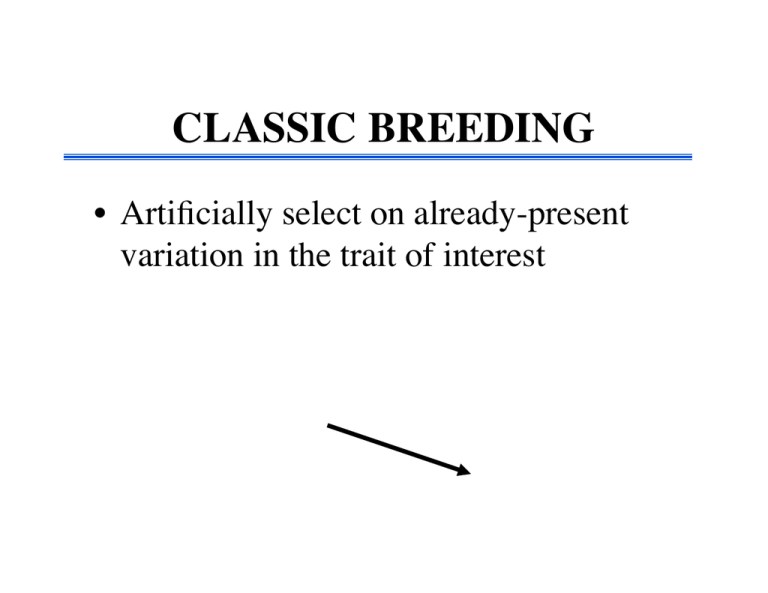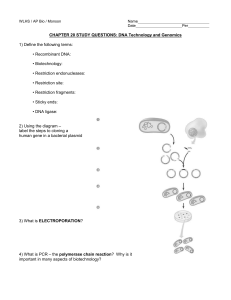Document 13888795
advertisement

CLASSIC BREEDING • Artificially select on already-present variation in the trait of interest TRUNCATED SELECTION NO BREED BREED f TRAIT VALUE A FACT • Molecular biology provides: – a means of combining genetic materials from vastly different sources – a means for rapid and precise identification of genotype at different levels of resolution TWO DNA TECHNOLOGIES • Recombinant • Non-recombinant RECOMBINANT DNA • TWO STEP METHOD: – Insert appropriate DNA sequence into vector – Insert vector into host cell BACTERIA HARBOR TWO ARANGEMENTS OF DNA • Chromosomal • Plasmids GETTING INSULIN GENE INTO VECTOR • STEP 1- Isolate human DNA • STEP 2 - Cut out insulin gene with restriction enzymes • STEP 3 - Cut plasmid with same restriction enzymes • STEP 4 - Glue insulin gene into plasmid RESTRICTION ENZYMES INSERTING A NEW GENE TRANSGENICS • Organisms that contain new DNA from other organisms (often different taxa). HOW TO INSERT TRANSGENES • Microinjection: insects, fish mammals fertizilized eggs • Biolistics: bombard plant tissue culture with DNA-coated particles • Sperm-mediated: coat(rodent, chicken) sperm with DNA vectors • Virus: expose embryos to retrovirus HOW TO INSERT TRANSGENES • …. TRANSGENIC MAMMALS • • • • • • Mice – human genetic disorders Marmosets – human disorders Goats - Biosteel Pigs – Enviropig Cattle – Herman The Bull Dogs – Ruppy (ruby glow) WORLD’S FIRST TRANSGENIC PET • ,,, Franken Foods? MISTRUST CONCERNS REGARDING GMO’S • New background, new expression • Expression throughout the organism • Constant or increased deployment of pesticides • Transfer of genes to pests • Dangers faced by monocrops • Wrong focus NON-RECOMBINANT METHODS • DNA technology that does not require recombination of DNA into another organism PCR • Polymerase Chain Reaction PCR AT WORK 1 HEAT 2 3 4 DNA POLYMERASE COOL A BIT HEAT A FACT • DNA consists of coding regions (genes) and non-coding regions • Some non-coding regions consist of many repeats of short sequences i.e. Short Tandem Repeats • The number of repeats at a given site varies among individuals but are more similar within lineages STR ANALYSIS • Compare the lengths of STR’s among individuals ANOTHER FACT • Since the DNA fragments are negatively charged, they will move through a porous gel via electric current at size-dependent rates DNA PROBE • A single strand of a particular sequence of nucleotide bases that is complementary to the fragment being sought A FACT • Adding a restriction enzyme to pool of DNA will give you many different restriction fragments of different sizes RFLP 4- STEP PROCESS • ISOLATE DNA • CUT USING ENZYMES • SEPARATE UNDER CURRENT • IDENTIFY USING PROBES A FACT • The length of particular restriction fragments can be highly variable RESTRICTION FRAGMENT LENGTH POLYMORPHISM - RFLP SOME QUESTIONS FOR GF TO ANSWER • Crimes - human, animal poaching • EPC’s • Phylogenies PCR AND FORENSICS . TESTING EVOLUTIONARY QUESTIONS COLOUR INTENSITY • From common ancestor or independent acquisition? AMBIENT LIGHT BARCODING A powerful tool for studying biodiversity? REMEMBER THIS? Cytochrome oxidase C Sequence of DNA code is ca. 700 units HOW MANY SPECIES? This “species” of skipper turns out to be 10 http://www.ornl.gov/TechResources/Human_Genome/home.html Begun in 1990, ... U.S. Department of Energy and the National Institutes of Health... Project goals are to identify all the 100,000 genes in human DNA, determine the sequences of the 3 billion chemical base pairs that make up human DNA, An important feature of this project is the federal government's longstanding dedication to the transfer of technology to the private sector...fostering the development of new medical applications. SEQUENCING BOTH THE MOSQUITO AND PLASMODIUM (MALARIA) GENOME PROBLEMS WITH BIOTECH. • Diagnostics • What is a bad trait? BIOINFORMATICS • The creation and of databases, algorithms, computational and statistical techniques and theory to solve formal and practical problems arising from the management and analysis of biological data STEM CELLS • Cells with the ability to divide for indefinite periods in culture and to give rise to specialized cells. CHARACTERISTICS OF STEM CELLS • Cells capable of renewing themselves through cell division, sometimes after long periods of inactivity. • They are unspecialized • They can be induced to become tissue- or organ-specific cells with special functions. COMPARE WITH OTHER CELLS • Muscle cells, blood cells and nerve cells do NOT normally replicate themselves EXAMPLES • In human embryo blastocyst, inner cells give rise to heart, lung, skin tissues, etc. • In some adult tissues (e.g. bone marrow) adult stem cells generate replacement cells for those lost through normal wear and tear CELL DIFFERENTIATION • (Somatic) Adult stem cells normally generate cells of the type of tissue on which they reside – e.g. blood forming stem cell • Embryonic stem cells are pluripotent – capable of differentiating into many types of cells CELL DIFFERENTIATION • (Somatic) Adult stem cells normally generate cells of the type of tissue on which they reside – e.g. blood forming stem cell CELL DIFFERENTIATION • Embryonic stem cells - In human embryo blastocyst, inner cells give rise to heart, lung, skin tissues, etc DIRECTED DIFFERENTIATION Pancreas or nerve cells? FUTURE TREATMENTS Brain injuries Spinal chord injuries Heart damage Missing teeth Deafness Diabetes




